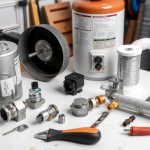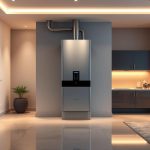Last summer, a simple shower turned into a nightmare when hot water burst out. This event made me look into water heater safety. I found important tips to avoid burn injuries that all homeowners should know.
Water heater safety is not just a rule—it’s a way to protect your family. Knowing about AO Smith water heater burn risks helps avoid accidents. It also keeps your home comfortable.
This guide covers key water heater safety tips. We’ll talk about how to avoid burn injuries and make your home safe.
Key Takeaways
- Understanding water heater burn risks is key for home safety
- Professional installation lowers the risk of hazards
- Regular maintenance stops sudden temperature changes
- Knowing emergency steps can stop serious injuries
- Setting the right temperature is vital for safety
Understanding AO Smith Water Heaters

AO Smith is a top name in water heating technology. They offer solutions for homes and businesses. Their water heaters are both high-tech and energy-saving.
Water heater technology has grown a lot. AO Smith leads with new features that boost performance and safety. There are many choices to fit different needs.
Product Range Overview
- Gas water heaters with Flammable Vapor Ignition Resistant (FVIR) technology
- Electric water heaters with advanced insulation
- Tankless models providing on-demand hot water
- Hybrid water heating systems
Energy Efficiency Highlights
| Model Type | Energy Factor (EF) | Annual Operating Cost |
|---|---|---|
| Standard Gas | 0.60-0.65 | $250-$300 |
| High-Efficiency Gas | 0.70-0.80 | $200-$250 |
| Electric Hybrid | 2.0-2.5 | $150-$200 |
“AO Smith water heaters represent a perfect blend of technological innovation and practical design.” – Industry Expert
The GAMA certification ensures AO Smith electric water heaters meet high standards. They have input ratings of 12 Kw or less. This means they provide reliable hot water and save energy.
Key Safety Considerations
- Integrated safety mechanisms
- Compliance with ANSI, ASME, and UL standards
- Advanced temperature control systems
- Durable construction materials
When picking an AO Smith water heater, think about your hot water needs. This will help you get the best performance and save energy.
Recognizing Water Heater Burn Hazards

Water heater burn risks are a big safety worry for homeowners. Knowing the dangers can help stop serious scalding and keep your family safe from water temperature issues.
Water temperature can get dangerous fast. Even a few degrees can raise the risk of scalding. Let’s look at the signs and causes of water heater burn hazards.
Signs of a Burn Risk
- Unusually hot water from faucets
- Steam or hissing sounds from the water heater
- Visible leaks or corrosion on the unit
- Sudden unexpected temperature changes
- Malfunctioning temperature controls
Common Causes of Burns
To prevent scalding, it’s important to know the main causes of water heater burn risks. Several factors can lead to burn hazards:
| Cause | Potential Risk |
|---|---|
| Incorrectly set thermostats | Extremely high water temperatures |
| Faulty temperature controls | Unpredictable water temperature |
| Malfunctioning pressure valves | Potential sudden temperature spikes |
Safety experts say to check water temperature often and use anti-scald devices to lower burn risks.
The key safety tips for water temperature suggest keeping it around 120°F (49°C). At this level, it takes over 5 minutes to cause a serious burn. This helps protect kids and those who are more vulnerable.
Remember, water heater burn risks can be greatly reduced with regular maintenance, proper installation, and watching your home’s water heating system closely.
Safe Operating Practices

Water heater safety starts with knowing how to control and maintain temperature. Homeowners can lower risks and save energy by following key practices.
Effective water heater temperature control begins with setting and monitoring the right temperature. The American Society of Sanitary Engineering suggests keeping water heaters at a specific temperature.
Recommended Temperature Settings
- Standard recommended temperature: 120°F (49°C)
- Prevents serious burn risks within 5 minutes
- Kills harmful bacteria effectively
- Reduces scalding dangers
*”Proper temperature management is the first line of defense in water heater safety”*
Regular Water Heater Maintenance Tips
Regular maintenance is key to home safety and saving energy. Experts recommend these routine checks:
- Annual tank sediment flushing
- Inspect anode rod every 2-3 years
- Check valves and connections for leaks
- Verify proper ventilation for gas heaters
Always prioritize safety during maintenance:
- Turn off power and water supply
- Wear protective gear (gloves, safety goggles)
- Check for gas leaks
Energy conservation improves with mindful water heater management. By keeping temperatures right and doing regular checks, homeowners save energy and keep systems running well.
Importance of Proper Installation

Installing a water heater needs skill and care. The right team can greatly improve your system’s performance and safety. Certified plumbers are key to making sure your AO Smith water heater works well.
- Following local plumbing codes
- Setting up electrical connections right
- Ensuring gas heaters have the right venting
- Choosing the best place for the unit
Hiring Certified Professionals
Look for certified plumbers with special training for water heater installation. They know the details of AO Smith systems and local rules.
“Proper installation is the foundation of safe and efficient water heater operation.”
Compliance with Local Codes
Local rules are strict to keep homeowners safe. Certified pros make sure your water heater meets these standards:
| Code Requirement | Purpose |
|---|---|
| Seismic Bracing | Prevent movement during earthquakes |
| Electrical Standards | Ensure safe power connections |
| Ventilation Specifications | Prevent carbon monoxide risks |
Choosing professional installation helps avoid risks and keeps your water heater running smoothly for years.
Emergency Protocols

Water heater accidents can happen without warning, posing burn and safety risks. Knowing how to respond quickly and how to treat burns is key. This helps reduce damage and keeps you safe.
Immediate Burn First Aid Steps
Act fast if you get burned from a water heater. The right steps can stop the injury from getting worse:
- Cool the burned area with running water for 15-20 minutes
- Remove clothing near the burn site carefully
- Cover the burn with a clean, sterile bandage
- Avoid applying ice directly to the burned skin
- Seek medical attention for severe burns
Water Heater Incident Reporting
Reporting water heater incidents is important. It helps makers make their products safer. It’s a big part of emergency response.
| Incident Type | Reporting Method | Required Information |
|---|---|---|
| Minor Burn | Manufacturer Customer Service | Model number, date of incident, detailed description |
| Serious Injury | Manufacturer & Local Authorities | Medical documentation, incident details, photographic evidence |
| Equipment Malfunction | Product Support Hotline | Serial number, specific malfunction description |
Critical Safety Recommendations
In big water heater emergencies:
- Evacuate the area immediately if gas leak is suspected
- Contact emergency services for severe burns or fires
- Disconnect power to the water heater if safe to do so
- Keep a fire extinguisher nearby for possible electrical fires
*Safety should always be your primary concern during any water heater emergency.*
Always get a professional check after a big water heater issue. It’s important for safety and to avoid future problems.
User Manual Insights
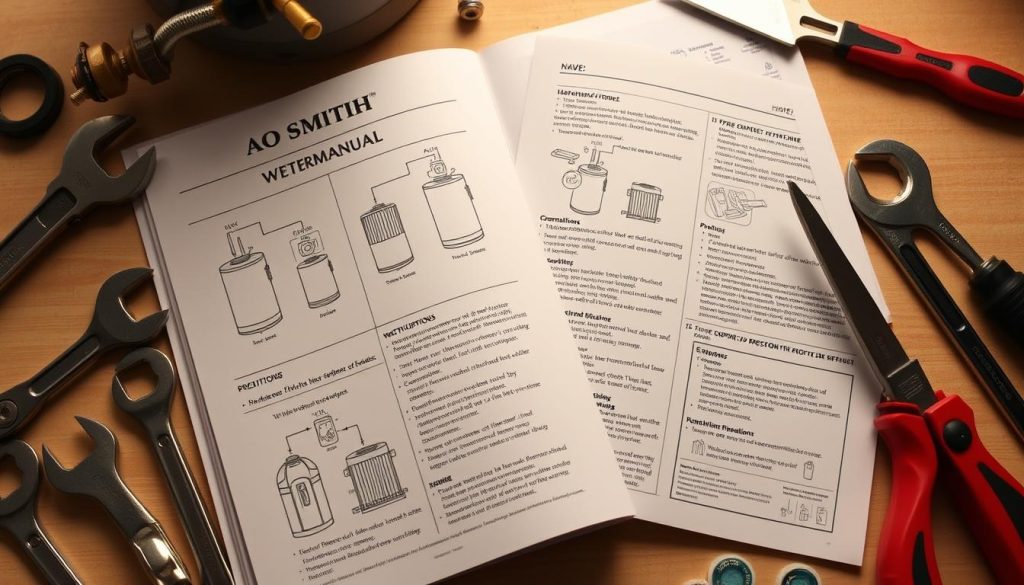
It’s important to understand your water heater user guide for safe use. The guide gives you key safety tips. These can help avoid dangers and make your AO Smith water heater last longer.
Essential Safety Information
The user guide has vital safety info for homeowners. It covers:
- How to install it right
- How to use it safely
- When to do maintenance
- How to spot risks
“Knowledge is safety when it comes to water heater operation.” – AO Smith Technical Team
AO Smith’s guide gives deep insights into system checks. For example, the Vertex GDHE-50 model has a smart control system. It:
- Keeps water at the right temperature
- Tracks heating cycles
- Does diagnostic tests
How to Access the User Manual
Finding your water heater’s user manual is easy. Here are ways to get your guide:
| Access Method | Details |
|---|---|
| Online Portal | Visit AO Smith’s official website |
| Model Number Search | Enter specific model details to download |
| Customer Service | Request digital or physical manual copy |
Pro Tip: Always keep a digital or physical copy of the manual in an easily accessible location for quick reference.
Maintenance for Burn Prevention

To keep your water heater safe from burns, you need to take care of it regularly. This care not only makes your water heater last longer but also keeps your home safe.
Having a good maintenance plan is key to avoiding sudden problems and burn risks. Experts say it’s important to follow a detailed plan to keep your water heater working well.
Monthly Visual Inspections
- Look for signs of rust or leaks around the water heater
- Listen for strange noises that might mean sediment buildup
- Check if the pressure relief valve is working right
- Make sure the temperature is set correctly
Annual Sediment Flushing Procedures
Sediment buildup can cause hotspots and make your water heater less efficient. A pro will flush the tank to get rid of these deposits and harmful stuff.
“Regular maintenance is the key to preventing unexpected water heater failures and safety risks.” – Water Heater Safety Expert
Critical Maintenance Recommendations
- Flush the tank every year to clear out sediment
- Change the anode rod every 3-5 years to stop tank rust
- Check the gas heater burners and venting
- Make sure the temperature is safe to avoid scalding
Experts say maintenance is more than just checking things. Knowing your system well helps avoid burn risks and keeps it running smoothly for a long time.
Troubleshooting Common Issues
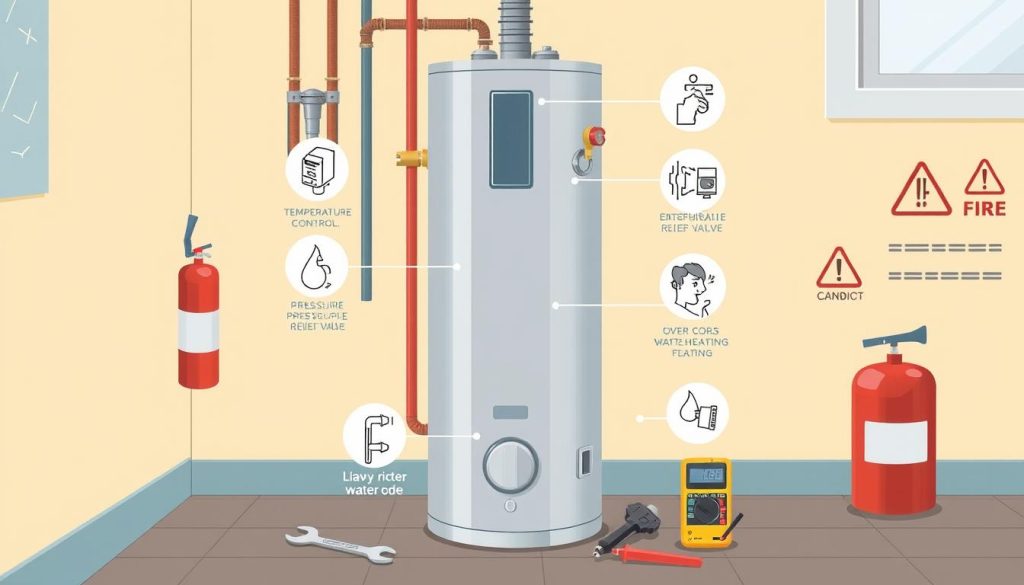
Fixing water heater problems needs a step-by-step plan. Knowing common issues can save you time and money.
Identifying Overheating Problems
Stopping overheating starts with spotting warning signs. Look out for excessive water temperatures, steam, or odd sounds. These signs point to possible issues with temperature control.
- Check thermostat settings carefully
- Inspect heating elements for damage
- Monitor water temperature consistently
Fixing Leaks and Pressure Issues
Fixing leaks fast is key to avoid water damage and inefficiency. Regular checks can catch problems early.
“Early detection of water heater issues can prevent costly replacements and safety hazards.”
- Examine pipe connections for loose fittings
- Check temperature and pressure relief valve
- Look for signs of corrosion
Water heater troubleshooting needs sharp diagnostic skills. If problems keep coming back, it might be time to call a pro.
| Issue Type | Common Symptoms | Recommended Action |
|---|---|---|
| Overheating | Extremely hot water | Adjust thermostat, inspect heating elements |
| Leaks | Water puddles around unit | Tighten connections, replace damaged parts |
| Pressure Issues | Frequent valve discharge | Check expansion tank, verify water pressure |
Warranty and Support

Understanding water heater warranties can be tough for homeowners. AO Smith offers strong warranty coverage. This is to protect your investment and give you peace of mind.
Understanding AO Smith Warranty Policies
AO Smith has great warranty protection for water heaters. It depends on the type and model. Most residential water heaters get coverage from 6 to 12 years.
- Standard coverage includes materials and manufacturing defects
- Warranty duration depends on specific model specifications
- Product registration is key for warranty activation
How to Access Customer Support
Getting help for your water heater needs some prep. Make sure you have all the right info before you call AO Smith’s support team.
- Find your water heater’s model and serial number
- Have your purchase proof ready
- Reach out to AO Smith through:
- Official website support portal
- Dedicated customer service phone line
- Email support channels
“Proper product registration is the key to unlocking your full warranty protection.” – AO Smith Technical Support Team
| Warranty Type | Coverage Duration | Key Features |
|---|---|---|
| Residential Tank | 6-12 Years | Parts and Labor Coverage |
| Commercial Tank | 3-5 Years | Limited Component Protection |
Keep your warranty valid by keeping records and registering your product. Regular upkeep can also help avoid problems and support warranty claims.
Alternatives to AO Smith
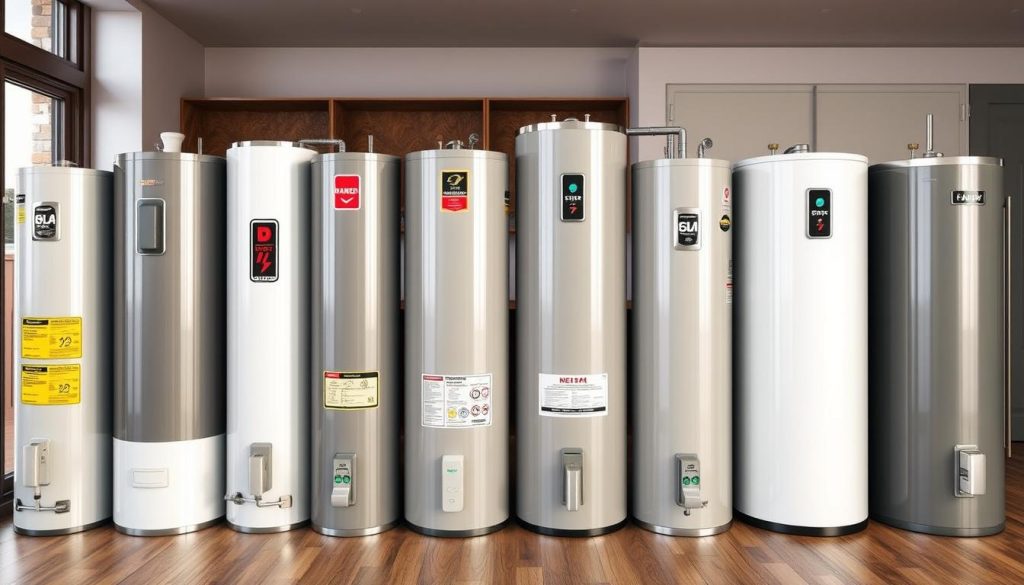
Looking at other water heater brands can help homeowners make better choices. They can compare products and see which ones are more energy-efficient. There are many brands out there that can meet different needs.
When picking a water heater brand, think about what matters most. Look at how well it performs and its value over time.
Popular Water Heater Brands
- Rheem: Known for energy-efficient models
- Bradford White: Specializes in commercial-grade residential units
- Rinnai: Leaders in tankless water heater technology
Comprehensive Product Comparison
Here’s a comparison of top water heater brands:
| Brand | Efficiency Rating | Technology Focus | Best For |
|---|---|---|---|
| Rheem | High (95-98%) | Hybrid Heat Pump | Energy Savings |
| Bradford White | 85-90% | Traditional Tank | Residential Durability |
| Rinnai | Up to 96% | Tankless | Space Efficiency |
Heat pump water heaters are a big step forward in saving energy. They work 300-500% more efficiently than old models. Plus, they qualify for a $2,000 tax credit under the Inflation Reduction Act.
“Choosing the right water heater involves balancing performance, efficiency, and long-term cost savings.”
When looking for an AO Smith alternative, focus on:
- High energy efficiency ratings
- Advanced safety features
- Enough capacity for your home
- Good warranty coverage
Home Safety Audits

Keeping your home safe starts with home safety inspections. Water heaters are a key part of home safety that needs regular checks.
Conducting a Complete Water Heater Safety Audit
A detailed check of your water heater is essential. Homeowners should look at important areas to keep it running well and safely:
- Check clearances around the water heater unit
- Verify proper ventilation for gas heaters
- Inspect electrical connections and gas lines
- Remove any flammable materials nearby
Key Water Heater Safety Devices
Using water heater safety devices can lower risks. Important safety tools include:
| Safety Device | Purpose | Recommended Action |
|---|---|---|
| Water Leak Alarms | Detect water damage | Install near the water heater base |
| Anti-Scald Devices | Stop dangerous water temperatures | Put on faucets and showerheads |
| Carbon Monoxide Detectors | Watch for gas heater exhaust | Place near the heating unit |
During a home safety check, focus on the temperature and pressure relief valve. Make sure it works right with a correct discharge pipe to avoid system failures.
“Regular maintenance is the key to preventing unexpected water heater complications and ensuring home safety.” – Home Safety Expert
Getting a pro to install water heater safety devices can give you peace of mind. Think about talking to a certified tech who knows local safety rules and can do a full safety check.
Community Resources
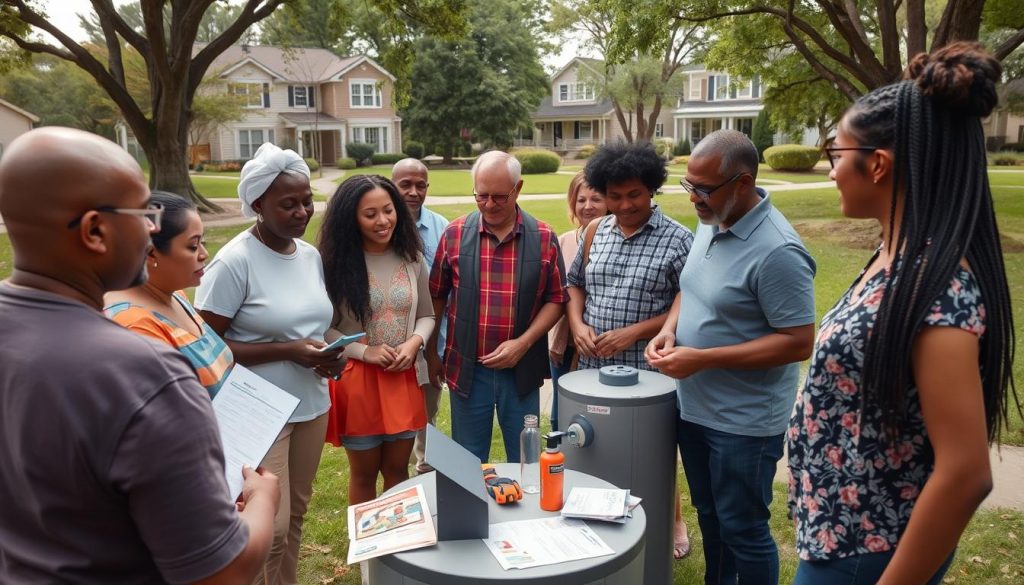
Finding reliable community resources is key to water heater safety. Knowing fire safety rules and plumbing laws helps homeowners avoid risks. It also keeps systems running well.
National Fire Protection Association (NFPA) Guidelines
The National Fire Protection Association sets important safety standards for water heaters. NFPA stats show water heaters caused nearly six thousand home fires from 2006-2010. This shows why getting professional advice is vital.
- Review NFPA 54 for detailed gas water heater safety standards
- Learn about essential fire safety rules for home water heaters
- Join community safety workshops and educational events
Local Plumbing Regulations and Support
Plumbing laws differ by area, often based on the International Plumbing Code or Uniform Plumbing Code. Local building departments are a big help for homeowners.
“Knowing local plumbing codes can stop safety problems and make sure water heaters are installed right.”
- Get in touch with local building departments for area-specific rules
- Ask for free safety checks at community centers
- Check with local fire departments for more safety tips
By using these community resources, homeowners can keep their water heating systems safe and efficient.
Conclusion and Final Recommendations
To keep your home and family safe, you need to take care of your water heater. Following water heater safety tips is key to keeping your heating system working well for a long time. It’s important to stay alert and know about any dangers or new rules.
Being aware of risks is very important. Regular checks, knowing what the maker says, and following safety tips can help avoid accidents. The Department of Energy’s new rules, starting July 21, 2023, show how serious safety is for water heaters.
Summary of Key Safety Practices
Homeowners can keep their homes and families safe by following safety steps. Make sure to get your water heater checked every year, watch the temperature, and look out for any signs of trouble. The new rules for water heaters show we’re always working to make them safer.
Encouragement for Proactive Maintenance
Looking after your water heater is essential for its long life and good work. Keep up with recalls, new rules, and tech updates. Think of your water heater as a vital part of your home’s safety, not just a tool.

